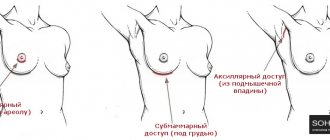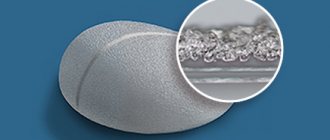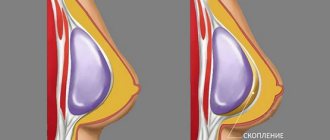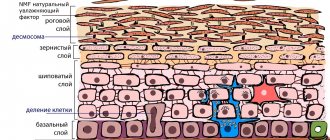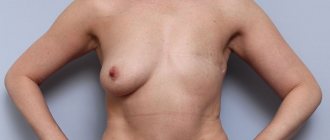Breast augmentation surgeries are among the most popular in the practice of plastic surgeons. The Novoklinik aesthetic medicine centers have accumulated extensive experience in various areas of mammoplasty. The clinic uses advanced equipment and safe, certified implants.
Breasts are a symbol of femininity, an important component of a woman’s image. Too small a size or loss of shape of the mammary glands can cause psychological problems and obsessive complexes in a woman. Modern methods of aesthetic surgery can correct cosmetic defects.
The choice of intervention technique is carried out taking into account the individual characteristics of the patient. And the result of plastic surgery is the ideal shape and most natural appearance of the breast, harmonious body proportions. Sign up for a consultation and find out how breast augmentation is performed by specialists at our clinic in Moscow.
Indications for surgery
The main indication for breast augmentation surgery is dissatisfaction with one’s own body due to insufficient volume and size of the gland.
Objective factors that require plastic correction include:
- a birth defect associated with an adverse effect on the breast bud;
- underdevelopment of the gland due to disruption of hormonal regulation during the period of active growth;
- traumatic, burn damage to an organ;
- congenital or acquired asymmetry of the glands;
- absence of breast tissue after mastectomy associated with cancer;
- loss of shape after pregnancy, lactation;
- age-related deforming processes;
- change in contours after losing body weight.
Subjective criteria are those in which there is no deficiency in the volume of the gland, and the woman wants to enlarge her breasts due to subcultural aesthetic norms, characteristics of professional activity (for example, work in the fashion industry), the requirements of a partner, and individual wishes.
The objective basis of beauty is in the harmonious proportions of the body. Before deciding on surgical correction, you need to discuss in detail with your doctor your personal expectations from the procedure and listen to the opinion of a professional.
Cons of mammoplasty
Like any operation, mammoplasty has its risks and complications. Surgical intervention involves a violation of the integrity of body tissues, and any factor can affect the course of the operation or the course of the postoperative period. Moreover, in an attempt to save money, some women turn to clinics with minimal prices. This indicates that it either employs inexperienced doctors, lacks full equipment, or uses low-quality implants.
Another disadvantage is the presence of a rehabilitation period, which requires strict adherence to a number of strict rules. In order for the recovery to be complete and without complications, from the first minute after surgery and over the next three months, the woman should listen to the doctor’s recommendations. They come down to various restrictions in daily activity, physical activity and even sleeping positions. For some patients, following these rules is quite difficult psychologically.
The result after mammoplasty is lasting, but not lifelong. Even the best implants and perfectly performed surgery cannot guarantee results for more than 10-15 years. Now we are talking about the aesthetic effect, and not about the shelf life of the implant. Endoprostheses retain their original shape and size, but over time, the surrounding tissues undergo age-related changes, which is why the effect of the operation is gradually lost.
Types of plastic surgery for breast augmentation
The most common and reliable type of augmentation mammoplasty is implantation of endoprostheses. Modern technologies make it possible to recreate the most natural breast shape in women with varying degrees of cosmetic defects.
The surgeon chooses the surgical technique based on the anatomical structure of the chest, the condition of the musculoskeletal skeleton, and the patient’s expectations. There are different ways to install endoprostheses. Their differences are in their location in relation to the pectoralis major muscle and in the method of surgical intervention.
The implant can be installed:
- superficial - directly under the breast tissue;
- under the pectoralis major muscle;
- under the connective tissue membrane of the pectoralis major muscle (fascia);
- combined - 2/3 under the fascia or muscle, 1/3 under the gland.
Types of surgical access differ in the location of the incision and the technical complexity of the intervention. Each of them has its pros and cons.
Submammary method
The method is indicated for patients with a well-defined inframammary fold. The incision is made in the crease under the breast. Its technical advantages are ease of implementation, good visibility of the operated field, preservation of sensitivity of the nipple-areolar zone. The disadvantage is a noticeable scar.
Periareolar method
Indications for this method of correction are a sufficient diameter of the areola, an additional need to reduce excess skin, elimination of a cosmetic defect at the base of the gland, installation of anatomical implants. The incision is made on the pigmented area of the areola. The advantage of this method is an invisible scar. The disadvantage is the likelihood of loss of sensitivity of the areola for up to 1 year.
Transaxillary method
Access is through the armpit. Significant advantages - a hidden incision provides an invisible scar, good fixation of the prosthesis is ensured, and the breast tissue is not injured. Disadvantages: inability to combine implantation with breast lift, limited visual control.
Periumbilical method
The implants are installed through the upper semicircle of the navel, creating a tunnel in the subcutaneous tissue. After correction, the scars are almost invisible, the organ tissue remains unharmed. Disadvantages: technical complexity, limited choice of biomaterials and installation location.
Endoscopic method
The prostheses are inserted endoscopically. Microscopic incisions are made in the armpit area. This is the least traumatic method, characterized by a short rehabilitation period and invisible scars. The operation is technically complex and has limitations in the choice of endoprostheses.
Breast reduction (reduction mammoplasty)
Reduction mammoplasty is a breast reduction surgery performed for women with macromastia (excessively large breasts). Women resort to reduction mammoplasty for a number of physical and aesthetic reasons:
- chronic back pain and poor posture resulting from high load on the spine;
- a rash under the breasts that appears due to diaper rash of the skin under the mammary glands;
- difficulties while playing sports;
- difficulties in finding suitable clothes and increased attention from the opposite sex, causing discomfort.
Reduction mammoplasty is performed under general anesthesia. During breast surgery, the surgeon removes some tissue, skin and fat deposits, which reduces the volume of the mammary glands and changes their shape.
Selection of implants
The choice of implant type is determined based on the volume of soft tissue of the chest area, exact parameters of the breast, and the optimal cost for the patient. Each type has its own positive and negative sides, indications and contraindications.
Breast augmentation - choosing implants
- Internal filler of the prosthesis:
- Silicone gel. Light composition, retains its shape well, feels natural to the touch. Can be installed above the pectoral muscle.
- Salt filler. The contents of the implant are saline solution. During the operation, it is possible to adjust the shape. Soft to the touch, has a risk of mechanical damage and limited service life.
- Bioimplants containing natural polymers. Enlargement using this method most closely resembles the natural shape of the breast, which is naturally firm to the touch. The material is technically easier to install.
- Implant shape:
- Round. Used to highlight the décolleté area.
- Anatomical. Used for classic gland enlargement and correction of asymmetry.
- Anatomical with a high profile. Suitable for slightly raised bust profile.
- Surface type:
- Smooth. They are better distributed in the cavity of the surgical pocket. More fragile, with a thin shell.
- Textural. They fit tightly in your pocket and take root well. Have a low risk of mechanical damage. There is a possibility of skin folds forming in the implant area.
Contraindications
Breast augmentation surgery is strictly not performed for a number of diseases:
- oncological processes;
- blood pathology;
- severe diseases of internal organs, heart;
- severe infections;
- diabetes;
- dermatitis and dermatoses in the operated area;
- autoimmune processes.
Also, the operation is not allowed for girls under 18 years of age and in a state of pregnancy or lactation. Surgical intervention is limited for unstable weight, benign neoplasms (the issue is resolved individually).
Preparing for anesthesia
Surgical correction is carried out only under general anesthesia. Therefore, the patient must undergo a series of examinations to determine whether the body is ready for the load.
The list of mandatory tests and diagnostic procedures includes:
- clinical blood test;
- biochemical blood parameters;
- determination of blood clotting;
- electrocardiogram;
- tumor markers, hormones;
- chest x-ray;
- testing for infections;
- Ultrasound;
- mammography and consultation with a mammologist.
Based on the diagnostic results, the anesthesiologist determines the presence of contraindications to augmentation mammoplasty and, together with the surgeon, selects the method of anesthesia.
Preparing for surgery
Proper preparation for plastic surgery reduces the risk of negative consequences and improves the recovery process. Rules for preparing for surgery:
- one month before the procedure, stop smoking and drinking alcohol;
- exclude medications that affect clotting within 2 weeks;
- within 7 days, switch to a balanced diet and reduce physical activity;
- stop using perfume products one day before;
- last meal - 12 hours before the intervention;
- Do not drink in the morning, take a shower, shave your armpits.
Breast augmentation surgery
The patient is hospitalized in the hospital on the day of surgery. Blood pressure and temperature are measured. All vital signs are monitored.
After induction of anesthesia, breast enlargement surgery is carried out in several stages:
- tissue is cut layer by layer;
- a pocket is formed for inserting the endoprosthesis;
- the implant is being installed;
- the dissected parenchyma is sutured with continuous sutures;
- drains are introduced to drain fluid;
- A cosmetic suture and an aseptic bandage are applied to the skin.
The mammary glands are supported by compression garments, and the patient is placed in a ward, where she is under active medical supervision for 24 hours. Hospital stay is up to 2 days.
Breast lift (mastopexy)
Mastopexy is a plastic surgery aimed at breast lift. Mastopexy is performed to correct sagging breasts, which develop due to a number of factors:
- pregnancy and breastfeeding (against the background of hormonal changes, weight fluctuations);
- age-related changes caused by decreased skin tone, sprained ligaments and decreased ability of tissue to regenerate;
- sudden weight loss.
Also, a surgical breast lift is performed for breast ptosis, a condition in which prolapse of the mammary glands occurs and loss of skin elasticity. A breast lift is possible with or without implants.
Postoperative period
During the rehabilitation period, the following recommendations must be strictly followed:
- Wear compression garments continuously for a month;
- exclude physical activity, sauna, heat exposure, intoxication;
- protect scars from injury by rough tissues and ultraviolet exposure;
- limit your sex life;
- See your doctor regularly.
Like any invasive intervention, breast enlargement is accompanied by some tissue changes in the area of correction. The final formation of scars in most cases ends after 6-12 months. Any violation of the recovery regime can lead to complications.
Sports after mammoplasty
During the recovery period, which takes up to two months, after breast surgery, you should limit physical activity (so as not to stretch the incision sites, increase blood pressure, or cause bleeding). Lifting heavy objects, performing physical exercises, or excessively stretching the arm muscles is strictly prohibited for 3-6 weeks (the exact time will be determined by your doctor).
A couple of days after the operation, it is recommended to start taking short walks in the fresh air. Walking improves blood circulation and promotes faster healing of wounds.
Prices for breast augmentation surgery
The cost of breast augmentation surgery depends on the technical complexity of the procedure, the material of the endoprosthesis, the volume of surgical intervention, and the pricing policy of the medical center. However, when choosing where to have plastic surgery, it is important to focus not only on the price of breast augmentation, but also on the reputation of a particular doctor or clinic.
Experienced aesthetic surgeons with extensive practice in such operations work at the Novoklinik aesthetic medicine and cosmetology centers. We will help you make your body more toned and attractive. You can get information about how much breast augmentation costs on our website or by phone.
Breastfeeding after mammoplasty
In the vast majority of cases, women who have undergone mammoplasty do not have problems with breastfeeding. They produce a sufficient amount of breast milk.
But problems with lactation can be observed after periareolar mammoplasty, in which an incision is made along the edge of the areola (in case of damage to the nerve endings of the mammary glands responsible for the production of breast milk). It can also be difficult to breastfeed after breast reduction surgery with nipple relocation (in case of damage to the nerve endings). With breast augmentation, there are usually no problems with breastfeeding, since modern techniques make it possible to place implants without affecting the tissue and nerves of the mammary glands.
3
0
2
Article rating:
5 out of 5 based on 2 ratings
Author: Lisitsin Ruslan Grigorievich
Plastic surgeon. Candidate of Medical Sciences. Highest category. Work experience 24 years.



